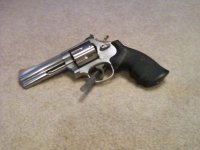dwever
Member
I think you were asking about the Pro Version since you mentioned 7 Shot. The PC version is an 8 shot and I would seriously consider that weapon. Mine can be seen at Doug Wever's Photo Galleries at pbase.com, but you really need to look up Exfeebe's pictures on this forum. Years ago, our agency used the 686, and as recently as last year we could purchase an anniversary model.
I have owned two 1911's, a S&W PC Melonite and an S&W Gun Site Edition Commander.
Why consider the Performance Center version .357 (2.625 barrel)?
First, in my opinion, most 686's, including the SSR's surprisingly, need action work out of the box for serious double action shooting. S&W offers that for around $150 for any 686 by their Performance Center I believe. Add in shipping and any charges from the gun shop you use, and it can add up.
2. Weight, Size, and Balance: For me at 6'1" and a little over 200 lbs. with big hands, the K frame in the 686 4" was slightly too light and too small in my hands. The K frame also transfers more recoil than the 37 oz. (2.625') or 44 oz. (5") PC N Frames. The N frame doesn't hurt even with .357 loads with wood grips.
3. Action: Both of my Perf Ctr 627's (5" and 2.625) the action has been smooth out of the case (I can drill a 25 yard silhouette shooting twice per second in double action in moderate light with the short barrel), the weight and balance is right, the size is just right. And of course the big N frame's going to handle recoil better.
4. Increased capacity and moon clips: I like the increased capacity of 8 rounds and option for moon clips carry, (particularly since I'm used to 15+1 + 2 spare 15 magazines when on duty with the mandatory Glock Model 22).
5. Perf Ctr being an N Frame doesn't conceal quite as well as the 686, but it is workable if you're intentional.
6. You don't have near the holster selection with the PC, but everything you need is out there. Three I recommend that are available for 686 or PC version: Galco High Ride, DeSantis Thumb Break Scabbard two slot, and Galco Combat Master.
I have owned two 1911's, a S&W PC Melonite and an S&W Gun Site Edition Commander.
Why consider the Performance Center version .357 (2.625 barrel)?
First, in my opinion, most 686's, including the SSR's surprisingly, need action work out of the box for serious double action shooting. S&W offers that for around $150 for any 686 by their Performance Center I believe. Add in shipping and any charges from the gun shop you use, and it can add up.
2. Weight, Size, and Balance: For me at 6'1" and a little over 200 lbs. with big hands, the K frame in the 686 4" was slightly too light and too small in my hands. The K frame also transfers more recoil than the 37 oz. (2.625') or 44 oz. (5") PC N Frames. The N frame doesn't hurt even with .357 loads with wood grips.
3. Action: Both of my Perf Ctr 627's (5" and 2.625) the action has been smooth out of the case (I can drill a 25 yard silhouette shooting twice per second in double action in moderate light with the short barrel), the weight and balance is right, the size is just right. And of course the big N frame's going to handle recoil better.
4. Increased capacity and moon clips: I like the increased capacity of 8 rounds and option for moon clips carry, (particularly since I'm used to 15+1 + 2 spare 15 magazines when on duty with the mandatory Glock Model 22).
5. Perf Ctr being an N Frame doesn't conceal quite as well as the 686, but it is workable if you're intentional.
6. You don't have near the holster selection with the PC, but everything you need is out there. Three I recommend that are available for 686 or PC version: Galco High Ride, DeSantis Thumb Break Scabbard two slot, and Galco Combat Master.
Last edited:

